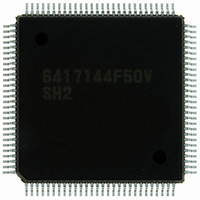HD6417144F50V Renesas Electronics America, HD6417144F50V Datasheet - Page 243

HD6417144F50V
Manufacturer Part Number
HD6417144F50V
Description
IC SUPERH MCU ROMLESS 112QFP
Manufacturer
Renesas Electronics America
Series
SuperH® SH7144r
Datasheet
1.HD64F7144F50V.pdf
(932 pages)
Specifications of HD6417144F50V
Core Processor
SH-2
Core Size
32-Bit
Speed
50MHz
Connectivity
EBI/EMI, I²C, SCI
Peripherals
DMA, POR, PWM, WDT
Number Of I /o
74
Program Memory Type
ROMless
Ram Size
8K x 8
Voltage - Supply (vcc/vdd)
3 V ~ 3.6 V
Data Converters
A/D 8x10b
Oscillator Type
Internal
Operating Temperature
-20°C ~ 75°C
Package / Case
112-QFP
For Use With
HS0005KCU11H - EMULATOR E10A-USB H8S(X),SH2(A)EDK7145 - DEV EVALUATION KIT SH7145
Lead Free Status / RoHS Status
Lead free / RoHS Compliant
Eeprom Size
-
Program Memory Size
-
Available stocks
Company
Part Number
Manufacturer
Quantity
Price
Company:
Part Number:
HD6417144F50V
Manufacturer:
Renesas Electronics America
Quantity:
10 000
- Current page: 243 of 932
- Download datasheet (6Mb)
Bus Mode and Channel Priority:
When a given channel is transferring in burst mode, and a transfer request is issued to channel 0,
which has a higher priority ranking, transfer on channel 0 begins immediately. If the priority level
setting is fixed mode (CH0 > CH1), channel 1 transfer is continued after transfer on channel 0 are
completely ended, whether the channel 0 setting is cycle steal mode or burst mode.
When the priority level setting is for round robin mode, transfer on channel 1 begins after transfer
of one transfer unit on channel 0, whether channel 0 is set to cycle steal mode or burst mode.
Thereafter, bus mastership alternates in the order: channel 1 → channel 0 → channel 1 → channel
0. Whether the priority level setting is for fixed mode or round robin mode, since channel 1 is set
to burst mode, the bus mastership is not given to the CPU. An example of round robin mode is
shown in figure 10.13.
10.4.5
Number of States in Bus Cycle: The number of states in the bus cycle when the DMAC is the
bus master is controlled by the bus state controller (BSC) just as it is when the CPU is the bus
master. For details, see section 9, Bus State Controller (BSC).
DREQ Pin Sampling Timing and DRAK Signal: In external request mode, the DREQ pin is
sampled by either falling edge or low-level detection. When a DREQ input is detected, a DMAC
bus cycle is issued and DMA transfer effected, at the earliest, after three states. However, in burst
mode when single address operation is specified, a dummy cycle is inserted for the first bus cycle.
In this case, the actual data transfer starts from the second bus cycle. Data is transferred
continuously from the second bus cycle. The dummy cycle is not counted in the number of
transfer cycles, so there is no need to recognize the dummy cycle when setting the TCR.
DREQ sampling from the second time begins from the start of the transfer one bus cycle prior to
the DMAC transfer generated by the previous sampling.
Number of Bus Cycle States and DREQ Pin Sample Timing
Priority: Round-robin mode
CH0: Cycle-steal mode
CH1: Burst mode
Figure 10.13 Bus Handling when Multiple Channels Are Operating
CPU
CPU
DMAC
CH1
DMAC CH1
burst mode
DMAC
CH1
DMAC
CH0
CH0
DMAC CH0 and CH1
round-robin mode
DMAC
CH1
CH1
10. Direct Memory Access Controller (DMAC)
DMAC
CH0
CH0
Rev.4.00 Mar. 27, 2008 Page 197 of 882
DMAC
CH1
DMAC CH1
burst mode
DMAC
CH1
REJ09B0108-0400
CPU
CPU
Related parts for HD6417144F50V
Image
Part Number
Description
Manufacturer
Datasheet
Request
R

Part Number:
Description:
KIT STARTER FOR M16C/29
Manufacturer:
Renesas Electronics America
Datasheet:

Part Number:
Description:
KIT STARTER FOR R8C/2D
Manufacturer:
Renesas Electronics America
Datasheet:

Part Number:
Description:
R0K33062P STARTER KIT
Manufacturer:
Renesas Electronics America
Datasheet:

Part Number:
Description:
KIT STARTER FOR R8C/23 E8A
Manufacturer:
Renesas Electronics America
Datasheet:

Part Number:
Description:
KIT STARTER FOR R8C/25
Manufacturer:
Renesas Electronics America
Datasheet:

Part Number:
Description:
KIT STARTER H8S2456 SHARPE DSPLY
Manufacturer:
Renesas Electronics America
Datasheet:

Part Number:
Description:
KIT STARTER FOR R8C38C
Manufacturer:
Renesas Electronics America
Datasheet:

Part Number:
Description:
KIT STARTER FOR R8C35C
Manufacturer:
Renesas Electronics America
Datasheet:

Part Number:
Description:
KIT STARTER FOR R8CL3AC+LCD APPS
Manufacturer:
Renesas Electronics America
Datasheet:

Part Number:
Description:
KIT STARTER FOR RX610
Manufacturer:
Renesas Electronics America
Datasheet:

Part Number:
Description:
KIT STARTER FOR R32C/118
Manufacturer:
Renesas Electronics America
Datasheet:

Part Number:
Description:
KIT DEV RSK-R8C/26-29
Manufacturer:
Renesas Electronics America
Datasheet:

Part Number:
Description:
KIT STARTER FOR SH7124
Manufacturer:
Renesas Electronics America
Datasheet:

Part Number:
Description:
KIT STARTER FOR H8SX/1622
Manufacturer:
Renesas Electronics America
Datasheet:

Part Number:
Description:
KIT DEV FOR SH7203
Manufacturer:
Renesas Electronics America
Datasheet:











